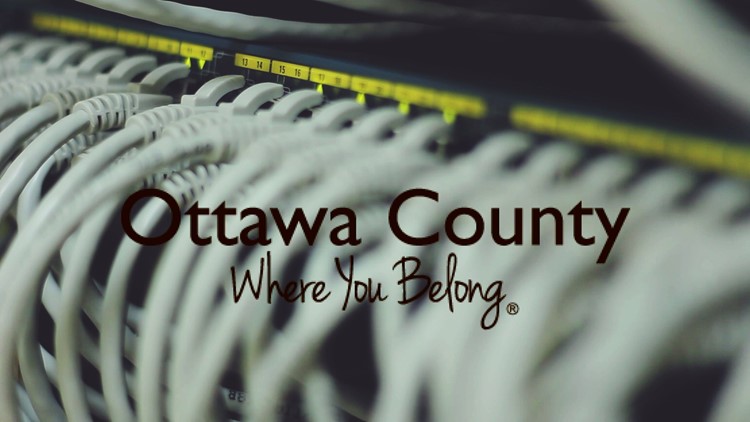OTTAWA COUNTY, Mich. — Ottawa County has an internet problem, according to a survey done by the county over several months.
The results of the Broadband Data Collection Survey are in, and they reveal that 10.5% of residents do not have access to fixed (wired or wireless) high-speed internet. 26% of those with fixed broadband access it at speeds slower than the FCC's minimum broadband threshold, a standard widely considered insufficient.*
Now, with the confirmation that there are gaps in availability, county leaders are sharing their plan for the next steps to fix the problem.
The survey was done by Merit Network, Urban Wireless Solutions, and Ottawa County, and their main objective was to refine broadband availability maps and capture a more accurate picture of current internet accessibility and future needs.
It is important to note that these results are just for Phase I of the County's 4-part Digital Inclusion Strategy.
"It was critical for us to commence with our own statistically validated study of broadband access needs because we do not have time to wait for the FCC or state to correct their data sets," said Ottawa County Department of Strategic Impact Director Paul Sachs. "To address our county's broadband access inequities now, we needed better maps."
According to a release from the county, this data collection effort was a critical undertaking since existing broadband coverage maps published by the FCC are widely recognized as flawed. "Almost everybody in the industry agrees that the FCC data is inaccurate. Even the FCC admits it," said Douglas Weber, president of Urban Wireless Solutions, a Digital Inclusion Strategy partner.
Funded by the County and its strategic partners, the survey was launched last summer by Ann Arbor-based internet research and educational organization Merit Network, Inc.
By the close of the data collection period, Merit received 3,940 responses. Based on the success of the effort, which resulted in statistically reliable data, Merit was able to interpolate (construct estimates based on collected statistics) data sets to provide a much clearer picture of household broadband needs countywide.
To capture as much data as possible, Merit and its strategic partners cast a wide net, said Pierrette Renee Dagg, director of Marketing and Communications for Merit. "With printed postcards, direct mail, newspaper ads, fliers, social media, email, and word-of-mouth, Merit, Ottawa County, and an array of strategy partners strived to reach everyone," said Dagg.
Besides revealing significant gaps in broadband access, the survey's data clearly shows service is insufficient, and there is significant demand throughout Ottawa County.
• Of the 10.5% of polled residents without broadband access, 72% said no services are available at their address; and 26% said the price is just too high
• 97% of residents without broadband internet access said they were willing to pay between $25-$101 for service. This indicates that most would pay for the service if it was made available
• Only 40% of served residents are satisfied with current provider options
• Only 15% of households have access at industry expert recommended minimum broadband speeds of 100 Mbps download/20 Mbps upload**
For a deeper dive into the data:
View the in-depth Topline Report PDF
Better Maps, Better Opportunities
A key goal of the survey was to create detailed maps to compare with FCC and other broadband data sets, said Department of Strategic Impact Director Paul Sachs.
"It was critical for us to commence with our own statistically validated study of broadband access needs because we do not have time to wait for the FCC or state to correct their data sets," said Sachs. "To address our county's broadband access inequities now, we needed better maps."
Ottawa County's data collection efforts are all the more important considering Michigan recently announced a new statewide high-speed internet assessment. To accomplish this, Lansing will be relying on data from ConnectMI's most recent study, performed in 2018. Once completed, new state-level broadband grant programs will be created. Eligibility for these grants will likely be tied to ConnectMI coverage maps - maps that, according to Paul Sachs, are inadequate.
"Like the FCC maps, ConnectMI's maps did not provide the level of fine detail needed to capture an accurate picture of service needs," said Sachs. "If the state chooses to embrace our more granular data from the survey, it could put us in a better position to compete for these new state programs."
Next steps: 'Ottawa Online' and developing solutions
To share this detailed broadband survey data and what's next for the four-phase Digital Inclusion Strategy, Ottawa County and its partners presented "Ottawa Online: Verifying Broadband Access Gaps" on Thursday, April 21, to a group representing local municipalities and nonprofits. County staff, Urban Wireless Solution's Weber, and Merit's Dagg reviewed survey results, highlighted key statistics, discussed how the data will be used, and paths and potential hurdles in the County's quest to ensure affordable and reliable internet access for residents and businesses.
"We were thrilled to share the study findings with local units of government and community stakeholders," said Sachs. "The strong support for this important work is tremendous and is only gaining momentum as we continue to advance down the path toward achieving digital equity. Having these data in-hand is a critical milestone to further our decision-making."
Following the afternoon presentation, local leaders asked important questions regarding funding challenges, balancing infrastructure needs with development plans, and the access needs of Ottawa County's agricultural sector. By connecting with local governments and community stakeholders, Ottawa County is fostering increased cooperation and facilitating open lines of communication to make the Digital Inclusion Strategy a success.
"Having this data is powerful. It demonstrates a tangible need in Ottawa County and provides a strong foundation for the County and its partners to seek improved connectivity for residents, businesses, and nonprofits alike."
Aaron Yore-VanOosterhout, GVSU's Dorothy A. Johnson Center for Philanthropy
"Having this data is powerful," said Aaron Yore-VanOosterhout, of GVSU's Dorothy A. Johnson Center for Philanthropy. "It demonstrates a tangible need in Ottawa County and provides a strong foundation for the County and its partners to seek improved connectivity for residents, businesses, and nonprofits alike."
On to Phase II
With local units brought up to speed, Ottawa County and Urban Wireless Solutions are turning their attention to Phase II of the Digital Inclusion Strategy: developing infrastructure plans, feasibility analyses of these plans, preliminary engineering designs, and a cost model. Key areas include addressing physical access issues (such as cost and equipment problems), and overcoming regulatory hurdles.
Although it is early in the process, a likely solution may be to develop a hybrid system that utilizes fiber and wireless technology in tandem. "We know it's not economically feasible to lay fiber to every home and business across the County," said Weber of Urban Wireless. "With wireless in some instances delivering speeds comparable to fiber, it may be more cost-effective."
Ottawa County will be releasing updates periodically as potential broadband infrastructure plans are developed and vetted over the next few months, including additional analytical maps based on the Merit survey data that will help drive decision-making with respect to furthering digital equity across the County. Eventually, internet service, fiber, and equipment providers - among others - will be brought in to help plan and build the infrastructure.
Public-private partnerships make it possible
Like many transformative projects, the Digital Inclusion Strategy depends on active participation from the private and nonprofit sectors.
"Yes - funding is becoming available for broadband expansion and internet service providers are working to expand their networks," said Sachs. "But because Ottawa County is committed to ensuring all residents have affordable and reliable access to broadband, we needed the data to make certain all efforts are directed to the right areas. Our Phase I funding partners made this data collection effort possible."
Partner involvement doesn't end here - having the backing of area businesses and nonprofits will continue to be imperative to effectively eliminate Ottawa's digital divide. Regional leaders such as Jim Brooks, former CEO of Beverage America and current regional strategist; and Helen Dietrich, owner of Ridgeview Orchards in Conklin, and Chester Township clerk, have voiced their support:
"Ensuring reliable and affordable internet access will only make this attractive region even more desirable, improving the quality of life and creating more opportunities for individuals and businesses to learn and thrive," said Brooks, who also sits on a number of community-focused boards, including Holland-Zeeland Model Communities Initiatives, and Talent 2025.
"Rural areas of the county continue to struggle to obtain reliable internet," said Helen Dietrich, who also is a member of the Ottawa County Data Collection Steering Committee. "This effort will ensure Ottawa's strong agribusiness sector can continue to compete on a high level."
As Phase II plans progress, Ottawa County will ensure transparency by providing periodic updates at MiOttawa.org/Broadband. To get a closer look at survey data, check out the Executive Findings Report. For more information on the Digital Inclusion Strategy and how to participate, check the website often, or contact the Ottawa County Department of Strategic Impact at plan@miottawa.org, or Douglas Weber of Urban Wireless Consultants at douglas.weber@urbanwireless.us
►Make it easy to keep up to date with more stories like this. Download the 13 ON YOUR SIDE app now.
Have a news tip? Email news@13onyourside.com, visit our Facebook page or Twitter. Subscribe to our YouTube channel.



